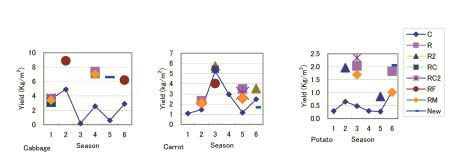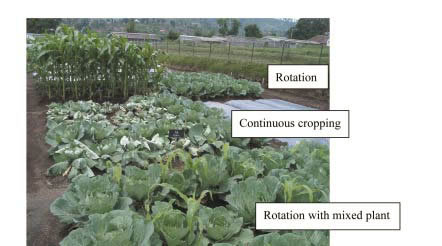Employing one-year crop rotations with three vegetable combinations to control clubroot damage in the West Java highlands
Description
[Objectives]
Indonesia is a typical tropical island country having a mountainous and volcanic terrain. Such geographical conditions are well suited for temperate vegetable cultivation such vegetables as cabbage, potatoes and carrots throughout the year. The highland farmers are eager to grow lucrative temperate vegetables including Culciferae family plants in continuous and/or highly frequent cropping and has now been brought the emergence of clubroot damage. In addressing the problem, short-term crop rotation systems that rotate three crop cycles within a year were tried in the tropical highland conditions.
[Results]
The continuous cropping (C) of cabbage produced the yield trend shown in Fig. 1. The C plot yields showed large fluctuations, but from the second season to sixth season, all values were lower than those produced from all the crop rotation cropping (R) plots, indicating that considerable yield reduction will occur when cabbage are grown continuously.
Since the third season, many cabbage plants in C plots died from clubroot disease and thereafter, severe clubroot damage was observed in C plots, the yield reduction was caused by clubroot disease. The effectiveness of the crop rotations was confirmed in the fourth season, after one year, namely one cycle of the rotations. The C plots were attacked by clubroot disease from early stage as shown by wilting symptoms (Fig. 2) and the yield was 2.57 kg/m2. On the other hand, those of the R plots ranged from 7.07 to 7.39 kg/m2 indicating the importance of crop rotation but no importance of sequence.
In the second season, early stage growth and the yields in plots kept in fallow during the last season were significantly better than those of the C plots. In the sixth season, these were compared again and a clubroot damage scores were 7 and 93 respectively suggesting the importance of removal of host plants for brief periods of time under moderate temperature conditions.
For the carrots which were combined in the crop rotations, no significant yield differences were not observed between any crop rotations suggesting less damage of continuous cropping at least until 6 times. Injury of continuous cropping of potatoes was also recovered by the crop rotations because of suppressing bacteria wilt damage.
Clubroot disease is a common in the West Java Highlands. However, the potential damage caused by clubroot disease can be mitigated by short-term crop rotations and these are a practical way to maintain cabbage and other vegetable production in ways that do not threaten the environment in these areas.
Figure, table
-
Fig. 1. Effects of continuous cropping on vegetable yield.
C, continuous cropping; R, Cabbage-carrot-potato rotation; R2, cabbage-potato-carrot rotation; RF, R rotation inserted with fallow cropping every two seasons; RC, R rotation, but inserted with corn after every vegetable; RC2, R2 rotation inserted with corn after every vegetable planting; RM, R rotation with mixed vegetables; New, cabbege plants were not cultivated for more than two years. -
Fig. 2. Damage caused by clubroot disease in a continuous cropping plot.
- Affiliation
-
Japan International Research Center for Agricultural Sciences Crop Production and Environment Division
- Term of research
-
FY2002 (FY2000-2002)
- Responsible researcher
-
YAMADA Mitate ( Crop Production and Environment Division )
AZIRIN Aziz ( Indonesian Vegetables Research Institute )
- ほか
- Publication, etc.
-
Akaike, Y. (1992): Effects of sweet corn cultivation in the field of severe outbreak of cabbage clubroot in highland area. New Technology Kanto Tokai Agriculture (H.3), 237-240 (in japanese).
Yamada, M. (2001): Methods of control of injury associated with continuous vegetable cropping in Japan - Crop rotation and several creatural practices. JARQ, 35(1), 39-45.
- Japanese PDF
-
2002_08_A3_ja.pdf1018.51 KB
- English PDF
-
2002_08_A4_en.pdf71.83 KB


